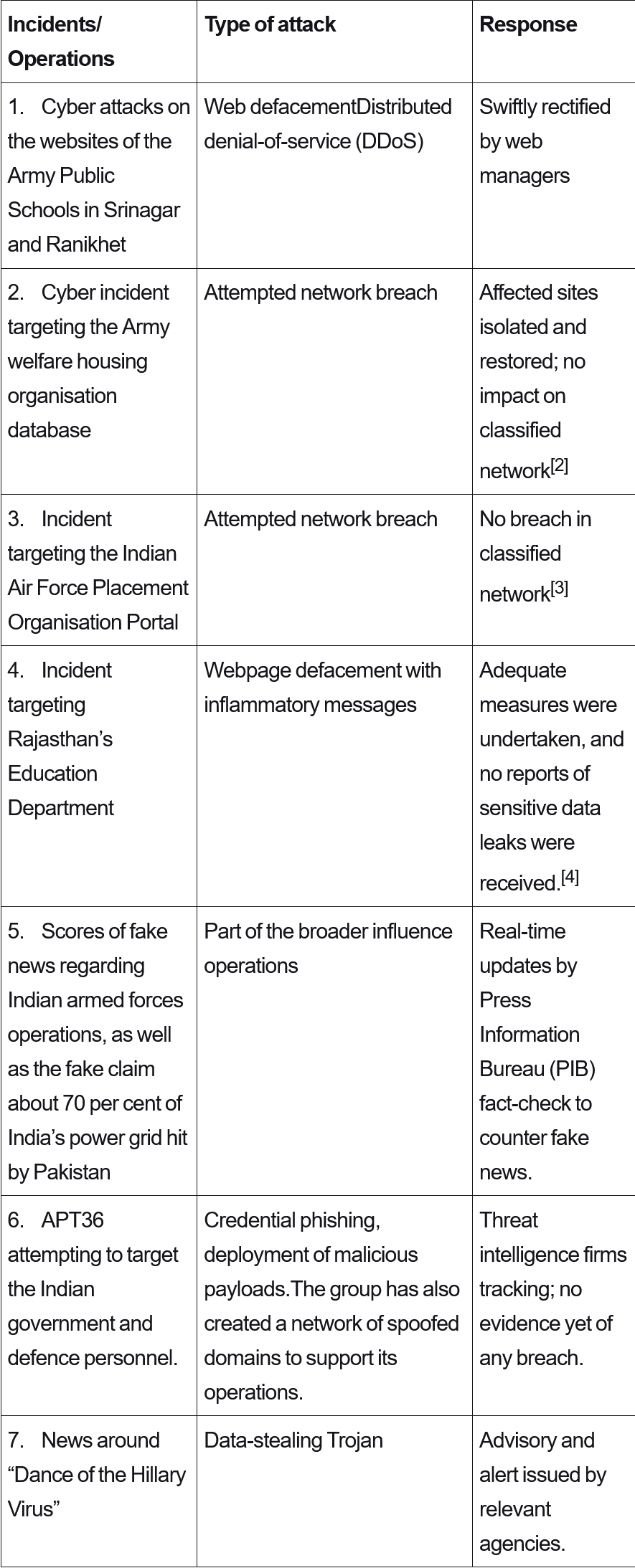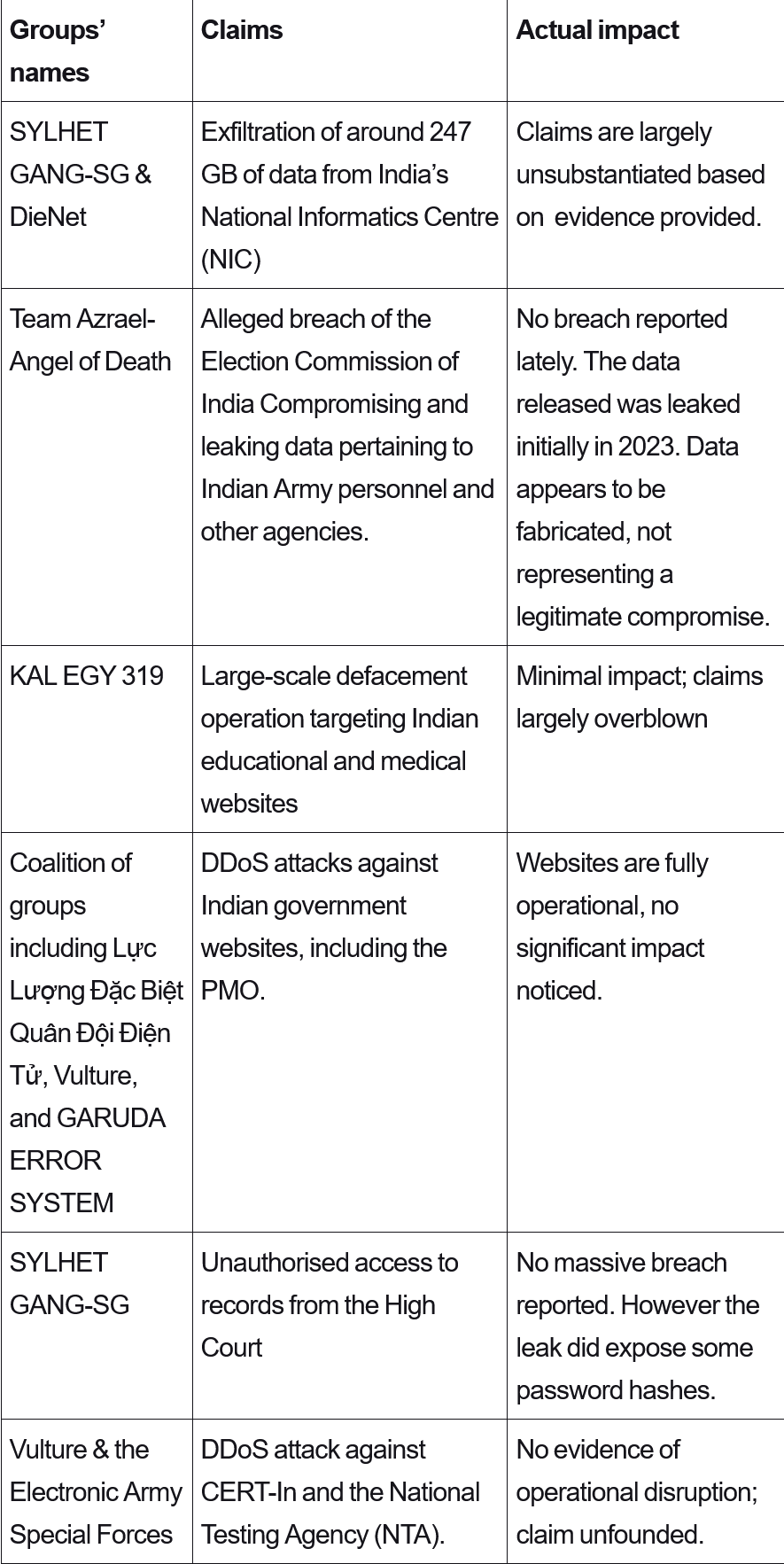Digital War: Pakistan’s Cyber Activity Against India – Analysis
On 7 May 2025, exercising its “right to respond”, Indian armed forces launched Operation Sindoor, under which they carried out precision strikes to destroy a network of terror camps in Pakistan and Pakistan-Occupied Kashmir. [1] The operation was undertaken in the wake of a terror attack in Pahalgam in which 26 tourists were murdered in cold blood. Defence Minister Rajnath Singh stated that the Indian armed forces carried out a focused, measured and non-escalatory response, intended to “break the morale” of the terrorists operating inside Pakistan.
Pakistani-affiliated hacker groups conducted a range of cyber attacks against Indian targets, even though none of them created any significant disruption. These attempts were first noticed following the Pahalgam attack and even before the escalation of the conflict, when websites associated with the armed forces were subjected to web defacement and online disruptions. Despite the fact that these intrusions were successfully thwarted by relevant agencies, the uptick in cyber attacks reflects a pattern seen in hot zones in Europe and West Asia.
Table 1. Cyber Operations against India following Pahalgam Attack

An early description of cyber-terrorism defines it as
premeditated, politically motivated attacks against information, computer systems, computer programs, and data which result in violence against non-combatant targets by sub-national groups or clandestine agents….[5]Government computer networks, financial networks, power plants, etc., are all possible targets as terrorists may identify these as the most appropriate features to corrupt or disarm in order to cause havoc. Manipulation of systems via software with secret “back doors”, theft of classified files, erasing data, re-writing web pages, introducing viruses, etc., are just a few examples of how terrorism can penetrate secure systems.[6]
Besides the three conventional domains of warfare—land, air and sea—modern conflicts are also being waged in the cyber realm. There are abundant examples of state-backed and independent hackers on both sides of the Russia–Ukraine conflict who have been mobilised to impose costs on their adversaries through cyber attacks. Similarly, there was a sharp increase in the number of cyber incidents during the initial phase of the Israel–Hamas conflict. These cyber operations have so far fallen short of causing any major or significant impact. However, underestimating the significance of such operations based only on outcomes would be a strategic mistake.
Scholars have long debated the role of cyber operations in managing escalation during a militarised crisis.[7] Strong doubts have been expressed about the role of cyber operations in crisis escalation, and the possibility of malicious behaviour in cyberspace leading to an armed conflict.[8] Instead, it is argued that cyber operations can be seen as a valuable way of projecting power, without indulging in armed conflicts.[9] Moreover, cyber operations “by their very nature are designed to avoid war”.[10] There is also a view that cyber operations could serve as de-escalatory offramps in the crisis. Given the nature of cyberspace, it is argued that prudence needs to be practised when considering cyber operations, as it may lead to inadvertent escalation.[11]
Pakistan’s Cyber Strategy
Pakistani aggression in the cyber realm can be categorised as Advanced Persistent Threat (APT) and hacker group activity, misinformation through social media platforms, and online activities by terror outfits. Pakistan-based APT groups actively targeted Indian infrastructure, conducting somewhat sophisticated and sustained operations against India’s interests. For instance, the APT actor, APT36 or Transparent Tribe, a threat group attributed to Pakistan, has been active since 2013,[12] and has primarily targeted Indian defence, government and diplomatic entities.
APT36 is known for its reliance on Crimson RAT, a remote access trojan used for data exfiltration and espionage. It frequently mimics Indian government websites to distribute malware. Following the Pahalgam attack, APT36 launched a cyber attack campaign spoofing India’s Ministry of Defence and “Pahalgam Terror Attack” themed documents to distribute malware, which could eventually be put to use to conduct information operations and espionage operations.[13]
Another Pakistan-based APT actor, Sidecopy, has also been active, sending out phishing emails impersonating official entities and delivering malware through fake domains mimicking legitimate services. During the conflict, Indian agencies identified seven APT groups operating against India that were also responsible for over 15 lakh cyber attacks.[14] Most of these attacks reportedly originated from Pakistan, Bangladesh and the West Asian region. However, these groups are not technically as advanced as Chinese APTs, which leverage zero-day exploits and conduct supply-chain attacks.
These activities have been flagged by various government agencies, and advisories have been issued.[15] India has undertaken anticipatory measures to secure its critical infrastructure and sensitive assets, including energy, defence manufacturing, telecommunications and transport.[16] The Department of Telecommunications (DoT) has been evaluating measures to enhance infrastructure. At the same time, the Indian Computer Emergency Response Team (CERT-In) has issued advisories pertaining to risks to banks and financial institutions. An advisory outlining the essential measures that need to be undertaken to secure MSMEs[17] was issued on 10 May, followed by one for large industries. In the latter advisory, the agency reported a sharp rise in ransomware attacks, DDoS incidents, malware infections and web defacements.[18]
Hacker group activity was much less consequential, and was largely found to be exaggerated. Such claims were largely disseminated through social media with screenshots of apparently successful hacks. Upon examination, most of these were found to be repackaging of earlier inconsequential breaches or databases without sensitive information. Many of these groups also claimed to be based in other countries.[19]
Table 2. APT and Hacker Group Claims[20]

Nonetheless, they provided grist to disinformation campaigns at a time when uncertainty about the crisis was widespread. The aim was to spread deceptive, misleading, or biased information, usually through troll accounts, automated bots and coordinated mass messaging on platforms such as Twitter, Facebook and WhatsApp.
A manual count shows that the Press Information Bureau (PIB) issued more than 60 fact-checks over five days to counter this tsunami of misinformation.[21] This included claims that an Indian Sukhoi Su-30MKI fighter jet had been shot down in Pakistan-Occupied Kashmir (POK) and that an Indian pilot was captured. According to the PIB, the photo being used to support the claim shows a Sukhoi jet that had crashed in Maharashtra in 2014.
These manipulated stories, false narratives, deepfakes, fake or misattributed imagery, and fabricated news stories were further amplified through the use of polarising hashtags. Even independent experts were sometimes taken in by this flood of misinformation, which left little time for authentication and sometimes unwittingly contributed to the further spread of the canards. The Ministry of Electronics and Information Technology issued orders to social media platform X to block 8,000 accounts.
Pakistan’s use of terrorists against India has not been limited to the conventional domain. Terror outfits such as Lashkar-e-Taiba (LeT) and Jaish-e-Mohammad have leveraged cyberspace extensively for recruitment, propaganda, communication, funding, planning and executing attacks.[22] Internet and social media platforms—including Facebook, Twitter, WhatsApp, Telegram and YouTube—have been effectively used to spread extremist ideology and to recruit followers.
Encrypted messaging apps and private social media channels are central for operational coordination and secure communication among group members. The LeT, for instance, has organised online and offline social media workshops to provide knowledge on exploiting online spaces to spread LeT ideology and objectives, and incite youngsters to engage in anti-India protests in the Kashmir Valley. The LeT has also used online gaming as a recruitment tool, providing links to a game titled “Age of Jihad” on one of its websites.[23]
The pause in hostilities notwithstanding, reports are pointing out that threat actors are still targeting Indian government websites.[24] The attack envelope is also expanding with reports of GPS spoofing, which typically involves manipulating GPS signals using software, and which, given its dual use, points to the increasing hybridisation of the battlefield and its secondary effect as an attack on critical infrastructure in use by millions.[25]
Conclusion
The ongoing cyberattacks targeting Indian infrastructure suggest growing reliance on cyber operations before, during, and after the cessation of military hostilities. Malicious actors were active as soon as reports of the Pahalgam attack surfaced, with a noticeable increase in their activities in the following days. Existing threat actors like APT36 created fake domains that mirrored legitimate services, which were used to deploy malware targeting the Indian government and defence personnel. Social media platforms were flooded with misinformation in a deliberate attempt to undermine public trust in Indian operations.
The Indian government responded swiftly, successfully thwarting many of the attacks in time. Official Indian handles on social media platforms like X proved highly effective in identifying fake news and played a key role in identifying and taking down the accounts responsible. That said, tactics such as phishing emails, infected mobile apps, spyware, and embedding hidden malware on websites to gain unauthorised access to sensitive information can only be countered through continuous vigilance and strict digital hygiene practices.
